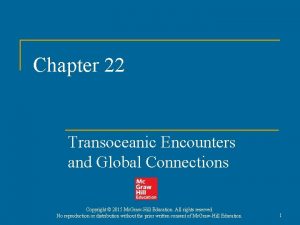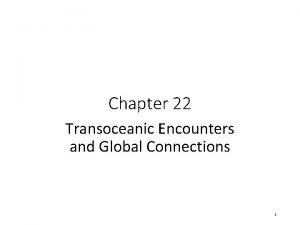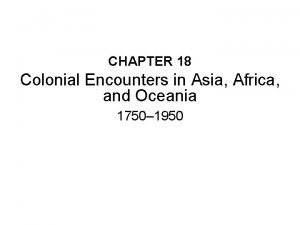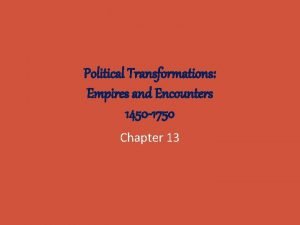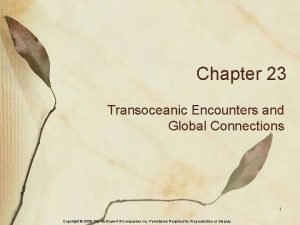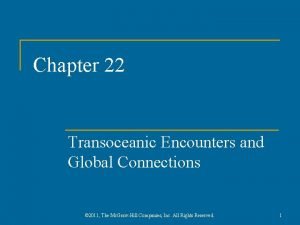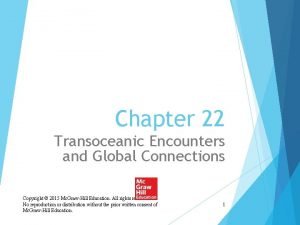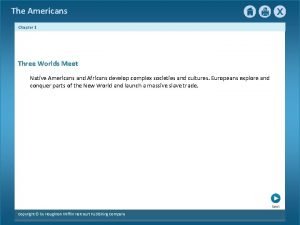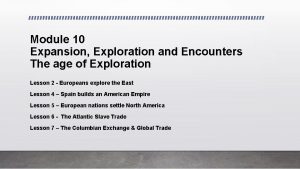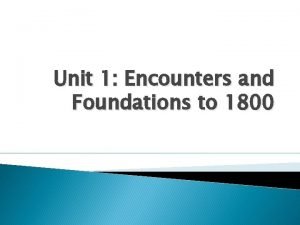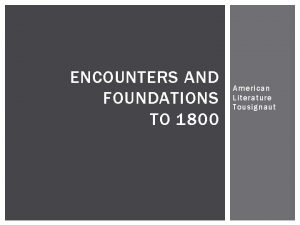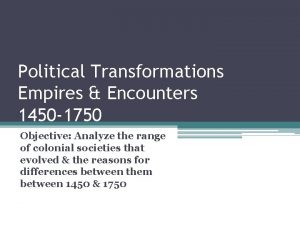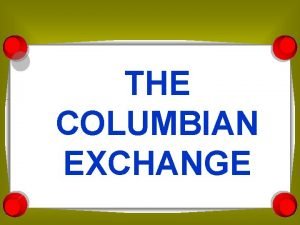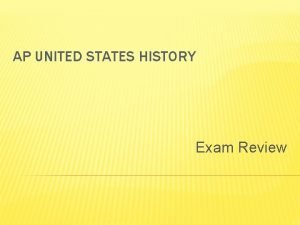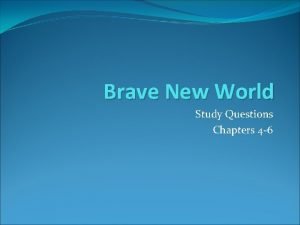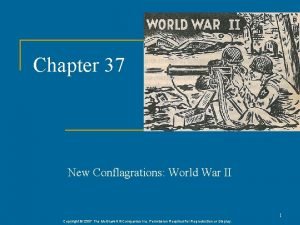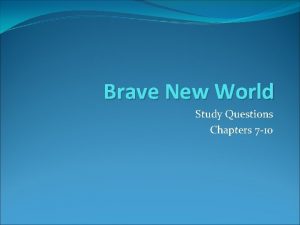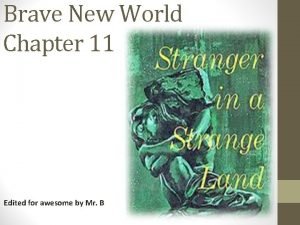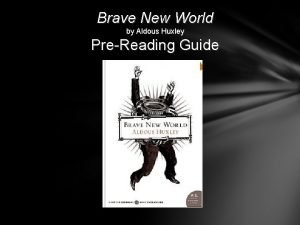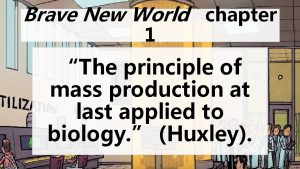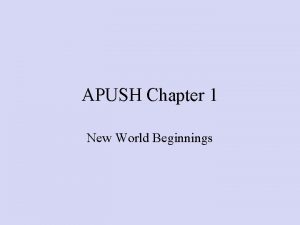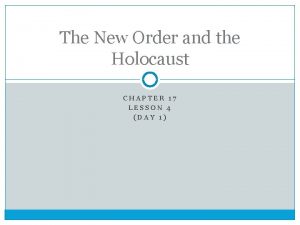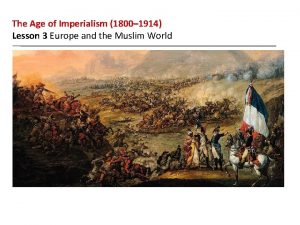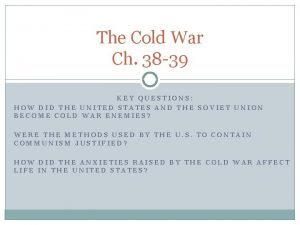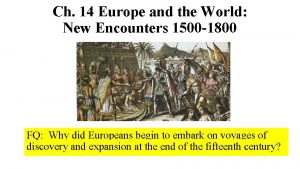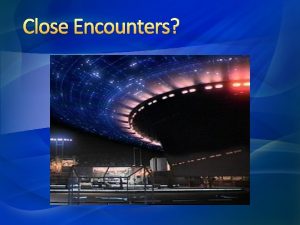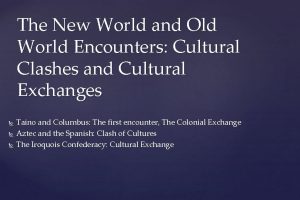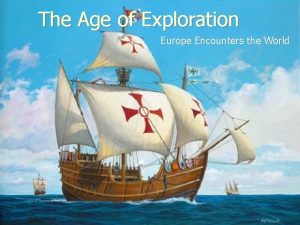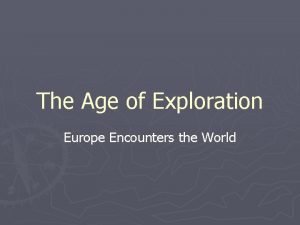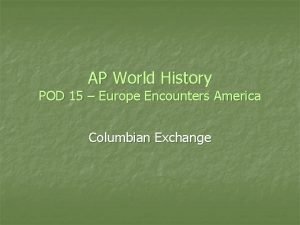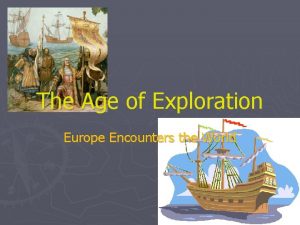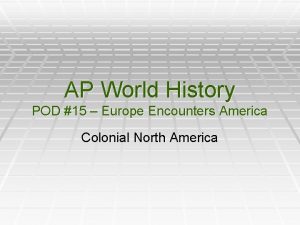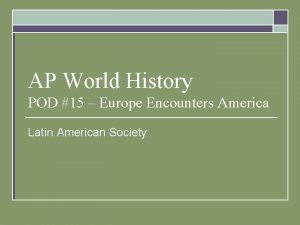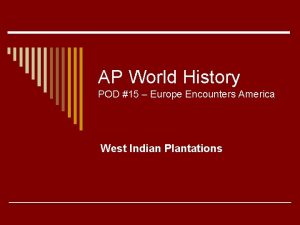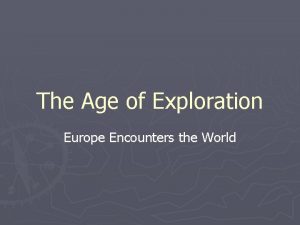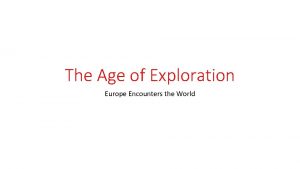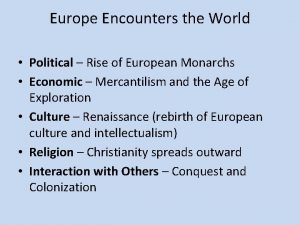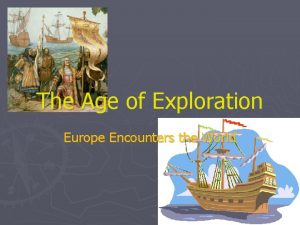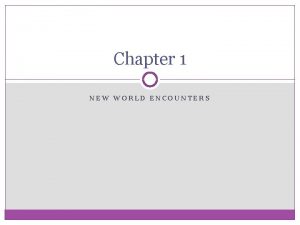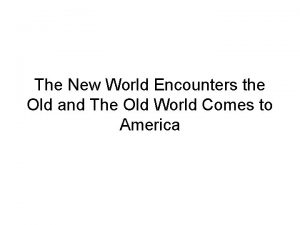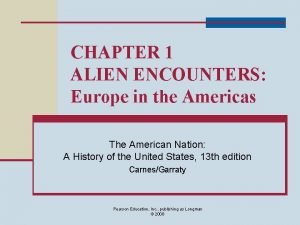Chapter 14 Europe and the World New Encounters






























































- Slides: 62

Chapter 14 Europe and the World: New Encounters, 1500– 1800

Focus Questions § § § Why did Europeans begin to embark on voyages of discovery and expansion at the end of the fifteenth century? How did Portugal and Spain acquire their overseas empires, and how did their empires differ? How did the arrival of the Dutch, British, and French on the world scene in the seventeenth and eighteenth centuries affect Africa, Southeast Asia, India, China, and Japan? What were the main features of the African slave trade, and what effects did it have on Africa? How did European expansion affect both the conquered and the conquerors? What was mercantilism, and what was its relationship to colonial empires?

§ Which European navigator is often associated with the first circumnavigation of the earth?

A 1536 Mercator projection map showing the route of Ferdinand Magellan’s first circumnavigation of the world p 399

• What were specific motivations for European exploration? • What made European exploration possible?

On the Brink of a New World § The Motives for Expansion § Fantastic lands § § The Travels of John Mandeville (14 th century) Economic motives § Access to the East § § § The Polos Religious Zeal The Means for Expansion § Maps § § Ptolemy’s Geography (1477, available in print) Ships and sailing § Navigational aids and enhanced knowledge

Ptolemy’s World Map Contained in the Latin translation of Ptolemy’s Geography was this world map, which did not become available to Europeans until the late 1400 s. p 402


New Horizons: The Portuguese and Spanish Empires § The Development of a Portuguese Maritime Empire § § Prince Henry the Navigator (1394 – 1460) The Portuguese in India § § Bartholomeu Dias and Vasco da Gama Viceroys § § § Alfonso d’Albuquerque (c. 1462 – 1515) Commercial – military bases In search of spices § Reasons for Portuguese Success § Guns and seamanship

Portuguese in India The Portuguese continued their exploration of India after gaining control of Goa in 1509 by moving northwards into the territory of Gujarat. p 403

List at least three differences between the Portuguese and Spanish empires.

MAP 14. 1 Discoveries and Possessions in the Fifteenth and Sixteenth Centuries Map 14. 1 p 404

Spices and World Trade (Slide 1 of 3) Vasco da Gama’s success in locating a route to the East by sailing around Africa shifted much of the control over the spice trade into Portuguese hands. The illustration shows a portrait of da Gama from ca. 1600. p 405

Spices and World Trade (Slide 2 of 3) The illustration is from a fifteenth-century French manuscript shows pepper being harvested in Malabar, in southwestern India. p 405

Spices and World Trade (Slide 3 of 3) The Venetians had played a dominant role in the spice trade via Constantinople, as is evident in the Venetian fresco shown. p 405

Voyages to the New World § The Voyages of Christopher Columbus (1451 – 1506) § Spanish financing to sail west to reach Asia § § § Reached the Bahamas (Oct. 12, 1492) Additional voyages (1493, 1498, and 1502) New Voyages § § § John Cabot Pedro Cabral Amerigo Vespucci Vasco Nunez de Balboa Ferdinand Magellan (1480 – 1521) § § Circumnavigation Treaty of Tordesillas (1494)

Christopher Columbus was an Italian explorer who worked for the queen of Spain. p 406

Put the following events in chronological order. Provided estimated years. -Spanish conquest of Aztecs -Columbus’ first voyage -Treaty of Tordesillas -Spanish conquest of Inca

CHRONOLOGY The Portuguese and Spanish Empires in the Sixteenth Century Event Dates Bartholomeu Dias sails around the tip of Africa 1488 The voyages of Columbus 1492– 1502 Treaty of Tordesillas 1494 Vasco da Gama lands at Calicut in India 1498 Portuguese seize Malacca 1511 Landing of Portuguese ships in southern China 1514 Magellan’s voyage around the world 1519– 1522 Spanish conquest of Mexico 1519– 1522 Pizarro’s conquest of the Inca 1530– 1535 p 406

• Which Mesoamerican civilization occupied modern-day Mexico prior to the Aztecs? • List at least three characteristics of the Aztec Empire.

The Spanish Empire in the New World (Slide 1 of 3) § § The Role of the Conquistadors Early Civilizations in Mesoamerica § The Maya § § Yucatan Peninsula Sophisticated calendar Accomplished artists The Aztecs § § Tenochtitlán By 1500, 80, 000 -200, 000 inhabitants Outstanding warriors Loose political organization

What factors led to Pizarro’s conquest of the Inca Empire?

The Spanish Empire in the New World (Slide 2 of 3) § Spanish Conquest of the Aztec Empire § § § The Inca § § § Hernan Cortés (1485 – 1547) Moctezuma (Montezuma) The leadership and conquests of Pachakuti Administration, buildings, and roads Spanish Conquest of the Inca Empire § Francisco Pizarro (c. 1475 – 1541) § The devastations of smallpox and Spanish weapons

List at least three characteristics of the administration of the Spanish Empire.

The Spanish Empire in the New World (Slide 3 of 3) § Administration of the Spanish Empire § § § Recreated urban cities of Spain Santo Domingo (1501) first Spanish city. Encomienda and impact Viceroys and audiencias The church Disease in the New World § § Sweeping epidemics of Old World disease High mortality rates and labor shortages

The Maya p 408

The Aztecs p 408

The Inca p 408

Aztec Victims of Smallpox The indigenous populations of the New World had no immunities to the diseases of the Old World, such as smallpox. By 1520, smallpox had spread throughout the Caribbean and Mesoamerica. p 412

• What is the common misconception about slavery that was discussed in Crash Course? Why is it wrong? • What elements of prior forms of slavery were found in the Atlantic Slave Trade?

New Rivals on the World Stage § Africa: the Slave Trade § Origins of the slave trade § § Cane sugar, plantations, and slavery Growth of the slave trade § Triangular trade § § § High death rate during the Middle Passage Conduct of the slave trade § § Up to 10, 000 African slaves taken to the Americas between the sixteenth and nineteenth centuries Prisoners of war Depopulation of African kingdoms Role of African middle men Effects of slave trade § Limited criticism of slavery

MAP 14. 2 Triangular Trade Route in the Atlantic Economy Map 14. 2 p 413

The Sale of Slaves In the eighteenth century, the slave trade was a highly profitable commercial enterprise. This painting shows a Western slave merchant negotiating with a local African leader over slaves at Gore´e, Senegal, in West Africa. p 415

What Southeast Asian kingdoms put up strong resistance to European expansion and eventually established trade with Portugal?

The West in Southeast Asia § European and Native Rivals § Portugal § § Spain § § The importance of the Philippines The Dutch and the English § § The limits of empire Dutch consolidation of economic, political, and military control The strength of mainland kingdoms in Burma (Myanmar), Thailand, and Vietnam

Southeast Asia, c. 1700 p 416

Europe in Asia (Slide 1 of 2) As Europeans began to move into parts of Asia, they reproduced many of the physical surroundings of their homeland in the port cities they built there. p 416

Europe in Asia (Slide 2 of 2) This is a seventeenth-century view of Batavia, which the Dutch built as their headquarters on the northern coast of Java in 1619. p 416

• What empire brought the many Hindu and Muslim kingdoms on the Indian subcontinent under one rule during the 16 th century? • Regarding European powers in India, what shift or change started to take place during the 17 th century?

The French and British in India § The Mughal Empire § § Babur (1483– 1530) Akbar (1556– 1605) Collapsed by mid-17 th century; power vacuum The Impact of the Western Powers § § The decline of Portugal’s dominance The increasing presence of the English § § Dutch and French competition Sir Robert Clive and the expansion of the East India Company § § § The “Black Hole of Calcutta” Battle of Plassey (1757) Forced withdrawal of the French

The Mughal Empire p 418

What was the result of Catholic missionaries in Japan in the mid 16 th century?

China & Japan § China § The Ming and Qing dynasties § § Dynastic shift (1644) and the greatness of Manchu China Western inroads § Imperial decline and European pressures § § Qing attempts to control trade Japan § § Shogun Tokugawa Ieyasu (1543 – 1616) Opening to the West § § Initial traders and missionaries welcomed Reactions against Westerners § Expulsion of missionaries and merchants

The Qing Empire p 419

The Portuguese Arriving at Nagasaki Portuguese traders landed accidentally in Japan in 1543. In a few years, they arrived regularly, taking part in a regional trade network involving Japan, China, and Southeast Asia. p 421

The Americas § The West Indies § § The British and French “sugar factories” British North America § § The Dutch and the New Netherlands The English § § Jamestown (1607) Control of the eastern seaboard § § The thirteen colonies and their roles French North America § Rivalries with Britain in Canada and Latin America

The West Indies p 421

A Sugar Mill in the West Indies Cane sugar was one of the most valuable products produced in the West Indies. By 1700, sugar was replacing honey as a sweetener for increasing numbers of Europeans. p 422

CHRONOLOGY New Rivals on the World Stage Event Portuguese traders land in Japan British East India Company formed Dutch East India Company formed English settlement at Jamestown Champlain establishes settlement at Quebec Dutch fort established at Batavia Dutch seize Malacca from the Portuguese English seize New Netherland English establish trading post at Canton Battle of Plassey French cede Canada to British mission to China Dates 1543 1600 1602 1607 1608 1619 1641 1664 1699 1757 1763 1793 p 422

• List three impacts of European exploration on non. Europeans.

The Impact of European Expansion (Slide 1 of 2) § The Conquered § Diverse effects § § § Devastating effects to local populations in America and Africa Less impact in Asia Creation of a multiracial society in Latin America Ecology: livestock and crops Catholic Missionaries § § § Conversion of native populations Hospitals, orphanages, and schools The Jesuits in Asia Conversions in China Japan

List three impacts of European exploration on Europeans.

The Impact of European Expansion (Slide 2 of 2) § The Conquerors § § Opportunities for men and women Economic effects § § § Plants and animals: the Columbian Exchange Impact on European lifestyle § § § Chocolate, coffee, and tea Deepening European rivalries New views of the world § § Gold, silver, and a price revolution Gerardus Mercator (1512 – 1594) and his map Psychological impact

Film & History: The Mission The Jesuit missionary Father Gabriel (Jeremy Irons) with the Guaraní Indians of Paraguay before their slaughter by Portuguese troops. p 424

MAP 14. 3 The Columbian Exchange Map 14. 3 p 426

A Seventeenth-Century World Map This beautiful world map was prepared in 1630 by Henricus Hondius. p 427

Describe at least one cause and one consequence of the Price Revolution.

Toward a World Economy (Slide 1 of 2) § Economic Conditions in the Sixteenth Century § § The causes and consequences of inflation The Growth of Commercial Capitalism § § Joint-stock trading companies New economic institutions § § § The Bank of Amsterdam (1609) Amsterdam Bourse (Exchange) Continuing dependence on agriculture

What were the chief beliefs of mercantilism?

Toward a World Economy (Slide 2 of 2) § Mercantilism § Chief beliefs and practices § § Total volume of trade unchangeable Importance of bullion and favorable balance of trade State intervention Overseas Trade and Colonies: Movement toward Globalization § § § The value of transoceanic trade Intra-European trade Trade patterns interlocked Europe, Africa, the East, and the Americas

Chapter Timeline p 429

Discussion Questions § § § Why were the Western European nations so well positioned for overseas exploration? How were the Spanish able to defeat the Aztecs? What social and economic forces drove the slave trade? How were the British able to achieve such a dominant position in Asia? What impact did European colonization have on the colonized? What economic changes occurred in Europe as a result of mercantilism and capitalism?
 Traditions and encounters chapter 22
Traditions and encounters chapter 22 Transoceanic encounters and global connections
Transoceanic encounters and global connections Chapter 18 colonial encounters in asia and africa
Chapter 18 colonial encounters in asia and africa Chapter 5 political transformations empires and encounters
Chapter 5 political transformations empires and encounters Traditions and encounters chapter 23
Traditions and encounters chapter 23 Chapter 22 transoceanic encounters and global connections
Chapter 22 transoceanic encounters and global connections Traditions and encounters chapter 20
Traditions and encounters chapter 20 Transoceanic encounters and global connections
Transoceanic encounters and global connections Chapter 1 three worlds meet
Chapter 1 three worlds meet Expansion exploration and encounters
Expansion exploration and encounters Encounters and foundations to 1800
Encounters and foundations to 1800 Encounters and foundations to 1800
Encounters and foundations to 1800 Encounters and foundations to 1800 comprehension answers
Encounters and foundations to 1800 comprehension answers Colonial encounters in asia africa and oceania
Colonial encounters in asia africa and oceania Political transformations empires and encounters
Political transformations empires and encounters Opposable thumb primates
Opposable thumb primates New world to old world columbian exchange
New world to old world columbian exchange Christ encounters
Christ encounters Lenses in literature
Lenses in literature Close encounters challenges
Close encounters challenges Transatlantic encounters in history of education download
Transatlantic encounters in history of education download Chapter 16 toward a new heaven and a new earth
Chapter 16 toward a new heaven and a new earth What is helmholtz watson's job
What is helmholtz watson's job Ap world history chapter 25 africa and the atlantic world
Ap world history chapter 25 africa and the atlantic world Chapter 37 new conflagrations world war ii
Chapter 37 new conflagrations world war ii Cyprus experiment
Cyprus experiment Brave new world discussion questions
Brave new world discussion questions Brave new world chapter 1
Brave new world chapter 1 Aldous huxley brave new world sparknotes
Aldous huxley brave new world sparknotes Brave new world chapter 11 questions
Brave new world chapter 11 questions New world
New world Malpais brave new world
Malpais brave new world Brave new world chapter 5
Brave new world chapter 5 Brave new world chapter 1
Brave new world chapter 1 Apush new world beginnings
Apush new world beginnings Brave new world feelies chapter
Brave new world feelies chapter The feelies
The feelies The new order in europe lesson 4
The new order in europe lesson 4 For which reason did persia attract foreign
For which reason did persia attract foreign Europe after ww2 map
Europe after ww2 map Hình ảnh bộ gõ cơ thể búng tay
Hình ảnh bộ gõ cơ thể búng tay Frameset trong html5
Frameset trong html5 Bổ thể
Bổ thể Tỉ lệ cơ thể trẻ em
Tỉ lệ cơ thể trẻ em Chó sói
Chó sói Chụp phim tư thế worms-breton
Chụp phim tư thế worms-breton Chúa sống lại
Chúa sống lại Các môn thể thao bắt đầu bằng tiếng bóng
Các môn thể thao bắt đầu bằng tiếng bóng Thế nào là hệ số cao nhất
Thế nào là hệ số cao nhất Các châu lục và đại dương trên thế giới
Các châu lục và đại dương trên thế giới Công thức tính thế năng
Công thức tính thế năng Trời xanh đây là của chúng ta thể thơ
Trời xanh đây là của chúng ta thể thơ Mật thư anh em như thể tay chân
Mật thư anh em như thể tay chân Làm thế nào để 102-1=99
Làm thế nào để 102-1=99 độ dài liên kết
độ dài liên kết Các châu lục và đại dương trên thế giới
Các châu lục và đại dương trên thế giới Thể thơ truyền thống
Thể thơ truyền thống Quá trình desamine hóa có thể tạo ra
Quá trình desamine hóa có thể tạo ra Một số thể thơ truyền thống
Một số thể thơ truyền thống Cái miệng xinh xinh thế chỉ nói điều hay thôi
Cái miệng xinh xinh thế chỉ nói điều hay thôi Vẽ hình chiếu vuông góc của vật thể sau
Vẽ hình chiếu vuông góc của vật thể sau Thế nào là sự mỏi cơ
Thế nào là sự mỏi cơ đặc điểm cơ thể của người tối cổ
đặc điểm cơ thể của người tối cổ
